Photo

Rune stone # U 226 - Bällsta, Arkils tingstad, Vallentuna socken
The inscription on this stone is a continuation of the rune inscription on stone U 225. As late as in the 1700s, there have also been a now lost stone line that connected the two rune stones according to drawings from that time.
*ristu stina uk staf uan uk in mikla at iartiknum uk kuriþi kas at uiri þu mon i krati kiatit lata kunar ik stin*
"De reste stenar och staven gjorde också den höga till hederstecken. Även Gyrid älskade maken. Därför i tårar skall talas om honom. Gunnar högg stenen"
"They raised stones and produced the staff and the great signs (of acclaim). Gyrid also cherished her husband. He will therefore be commemorated in weeping. Gunnar cut the stone"
© utrianalax
3 notes
·
View notes
Photo
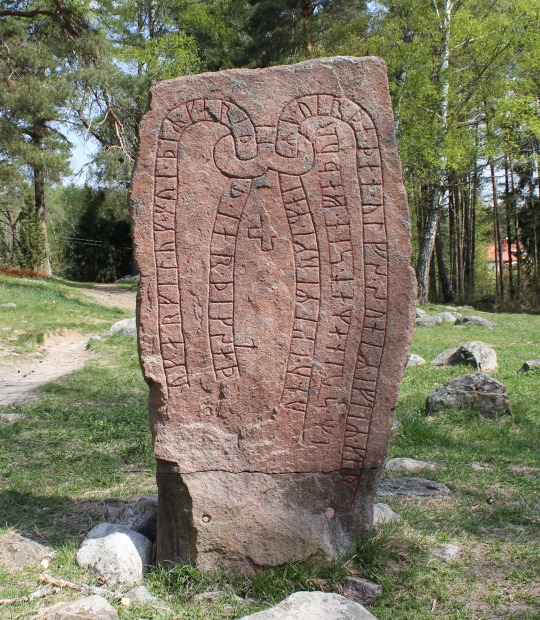
Rune stone # U 225 - Bällsta, Arkils tingstad, Vallentuna socken
This rune stone of granite forms and is a monument together with rune stone U 226 which stands about twenty meters away and nearer to the Vallentuna lake.
The height is 1.80 meter and width in the center of the rune stone is 0.94 m. The inscription is clear and well preserved.
*...uk arkil uk kui þiʀ kariþu iar þikstaþ ... ...unu iki mirki maiʀi uirþa þan ulfs suniʀ iftiʀ kir... ...iʀ suinaʀ at sin faþur*
"Ulvkel och Arnkel och Gye de gjorde här tingsplats . . . Ej skall en större än den Ulvs söner raska svenner, minnesvård finnas, gjorde efter [honom], åt sin fader"
Ulvkel and Arnkel and Gye, they made the Assembly-place here ... No landmark will be more (great), than (the one) the sons of Ulv made in (his) memory; able lads in memory of their father"
© utrianalax
#u#225#u225#bällsta#vallentuna#arkils#jättingstad#ulvkel#arnkel#gye#ulv#skålhamra#uppland#tingsplats
26 notes
·
View notes
Photo

Rune stones # U 225 & U 226 - Bällsta, Arkils tingstad, Vallentuna socken
These two rune stones and the square stone construction are the remains of an early eleventh century village council. At this place people came together to administer justice, or come to important decisions. The inscriptions on the rune stones tells us about a local chief, Ulv in Skålhamra, who lived here during the eleventh century. He belonged to one of the two families of great significance, who resided in this area during the late Viking Age (the other family was the clan of Jarlabanke).
Arkils tingstad means "Assembly location of Arkil" and was the first assembly place in the Vallentuna area.
© utrianalax
12 notes
·
View notes
Photo
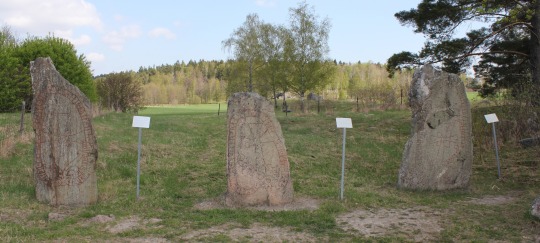
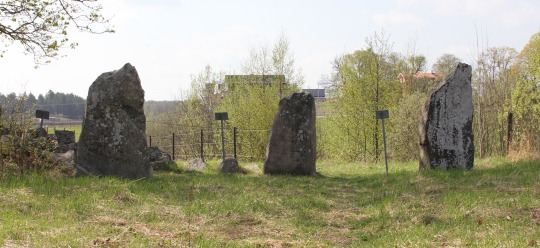
Rune stones # U 135, U 136, U 137 - Broby, Täby socken
© utrianalax
1 note
·
View note
Photo
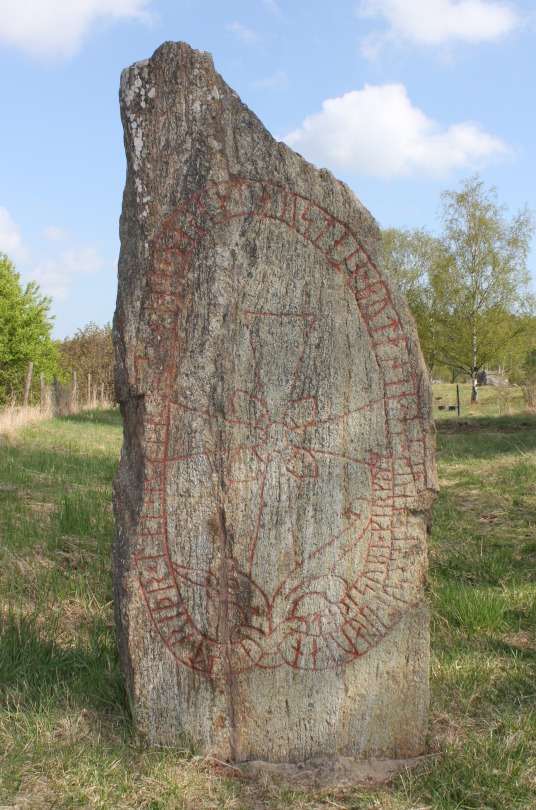
Rune stone # U 136 - Broby, Täby socken
This rune stone is 1.73 meters tall and has a well preserved inscription. Östens journey to Jerusalem is regarded as the oldest known pilgrimage from our country. The rune stones golden age during the 1000's coincided with the beginning of the Christian mission in the region.
*astriþr lat raisa staina þasa at austain buta sin is suti iursalir auk antaþis ub i kirkum*
"Estrid lät resa dessa stenar efter Östen, sin man, som drog till Jerusalem och dog borta i Grekland"
"Estrid had these stones raised in memory of Östen, her husband, who travelled to Jerusalem and met his end up in Greece"
© utrianalax
5 notes
·
View notes
Photo
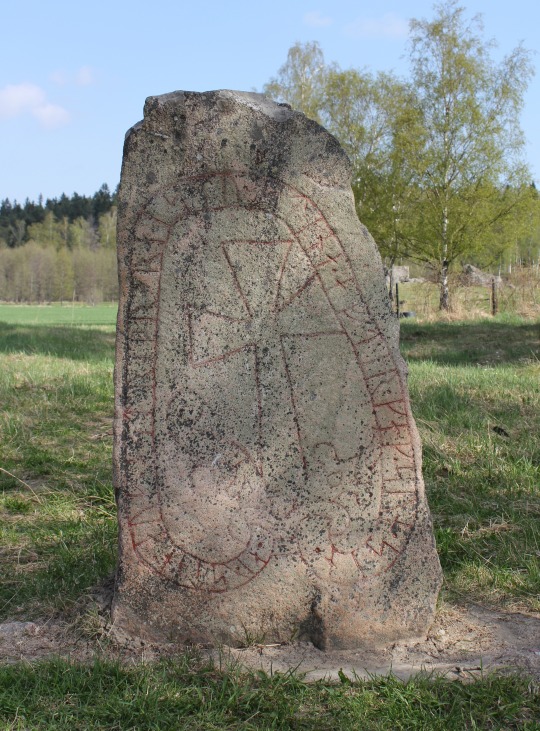
Rune stone # U 137 - Broby, Täby socken
This run stone is Jarlabanke family's oldest monument. Östen and Estrid who are mentioned on the stone was Jarlabankes grandfather and grandmother. Kag, for whose memory this rune stone was made for, was the brother of Jarlabankes father Ingefast who is mentioned on the rune stone # U135.
The rune stone is of granite and 1.38 meters high. It was discovered in 1930 during roadworks. It was 1.5 meters below the ground in the former embankment where it sometime for many hundreds of years ago must have fallen.
*aystin auk astriþr raistu stina aftir kak sun sin*
"Östen och Estrid reste stenarna efter Kag, sin son"
"Östen and Estríd raised the stones in memory of Kag, their son"
© utrianalax
6 notes
·
View notes
Photo
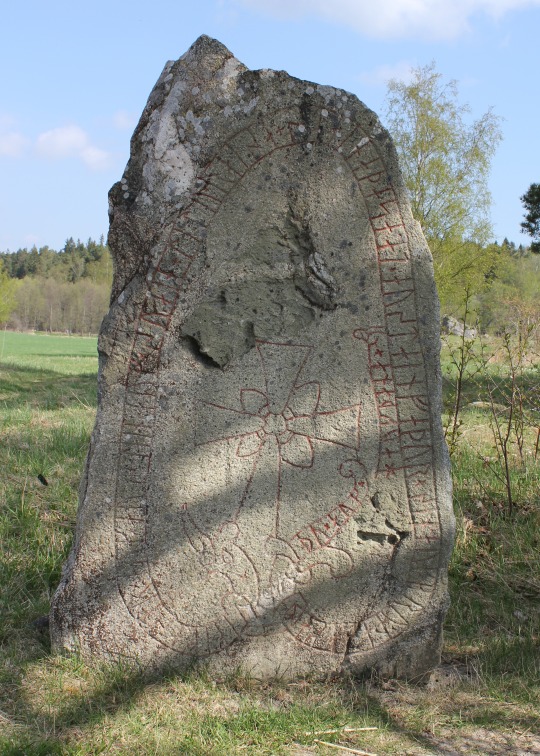
Rune stone # U 135 - Broby, Täby socken
The bridge mentioned in the inscription has given the name to the farm Broby. The sons of Östen did also built up a large pile. But it was no burial mound - but a cenotaph, ie an empty tomb built on a place where the dead´s not buried. We know that Östen died in Greece according to other rune stones in the area. The pile is today completely gone.
*ikifastr auk austain auk suain litu raisa staina þasa at austain faþur sin auk bru þasa karþu auk hauk þana*
»Ingefast och Östen och Sven läto resa dessa stenar efter Östen, sin fader, och de gjorde denna bro och denna hög"
"Ingefast and Östen and Sven had these stones raised in memory of Östen, their father, and made this bridge and this mound"
© utrianalax
2 notes
·
View notes
Photo

Rune stone # U 150 - Karby, Täby socken
This rune stone is unfortunately damaged and parts of the stone is missing. There is no beginning and end of the inscription, but the full text is known thanks to drawings from the 1600s, when the stone still was intact.
Jarlabanke and his family have raised a great number of stones in Täby and surrounding parishes.
*iarla baki auk fastui litu raisa stina aftiʀ suain sun sin*
"Jarlabanke och Fastvi läto resa stenarna efter Sven, sin son"
"Jarlabanke and Fastvi had the stones raised in memory of Sven, their son"
© utrianalax
0 notes
Photo
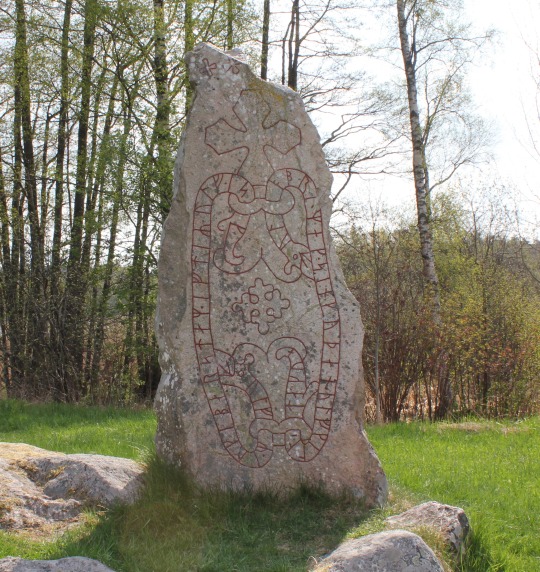
Rune stone # U 161 - Risbyle, Täby socken
The runes on this stone was carved by Ulv in Bårresta. The family had strong ties of friendship to him. Boresta is only about 10 kilometers away from here. From the other rune stones in the area, we know that Ulf has participated in all three Viking campaigns against England and he was probably a wealthy and respected man in the village.
The stone was carved sometime between 1010 and 1050 and the cross in the middle of the stone is of Russian-Byzantine type and is today used as the Täby Municipality crest.
*ulfʀ iuk i barstam iftiʀ ulf i skulobri mak sin kuþan ulfkil lit akua*
"Ulv i Bårresta högg efter Ulv i Skålhamra, sin gode frände. Ulvkell lät hugga"
"Ulv of Bårresta cut (the stone) in memory of Ulv in Skålhamra, his good kinsman-by-marriage. Ulvkell had (it) cut"
© utrianalax
1 note
·
View note
Photo
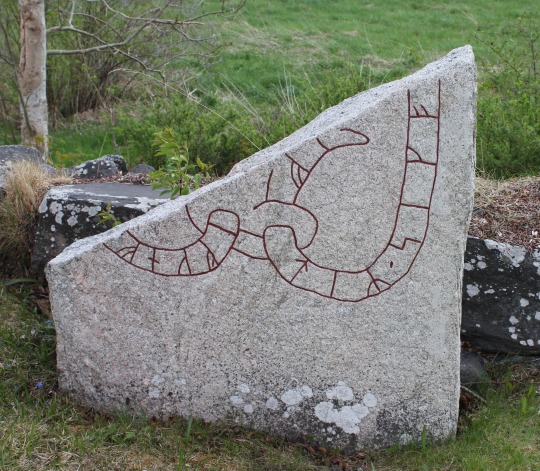
Rune stone - U 221 - Vallentuna kyrka & socken
The lower part of the rune stone was found in 1939 at grave diggings, 40 meters southeast of the church, in the cemetery. The fragment is now raised at the eastern cemetery wall. The stone is of grey granite.
*..ifkn f... ...ftiʀ sikf...*
"...efter Sigfast..."
"...in memory of Sigfast..."
© utrianalax
0 notes
Photo
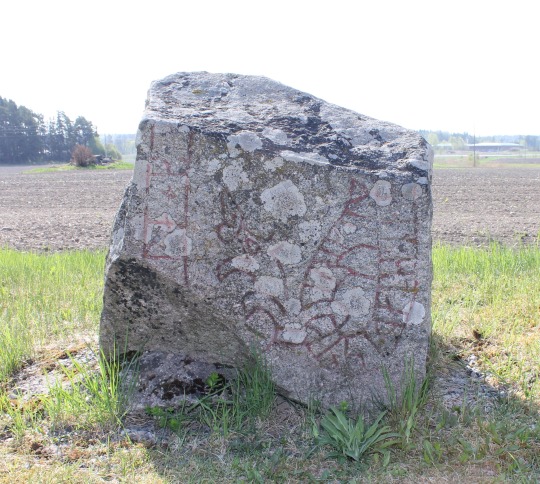
Rune stone # U 140 - Broby, Täby socken
By judging the inscription of this rune stone fragment it must have been raised by the great man Jarlabanke over someone who died in Greece. With Greece the entire Byzantine Empire is meant.
Jarlabanke was a great man in Uppland, who owned large estates in Täby and Vallentuna in the1000's . Jarlabanke and his family are mentioned in a larger number of rune stones in the neighborhood.
*...laba... ... han entaþis i kirikium*
"(Jarl)aban(ke)... ...han ändades i Grekland"
"Jarlabanke ... He met his end in Greece"
© utrianalax
0 notes
Photo
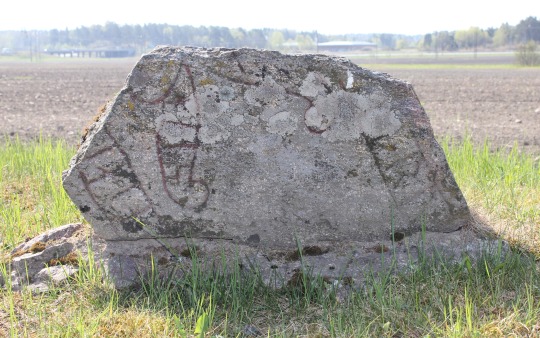
Rune stone # U 139 - Broby, Täby socken
A fragment of a rune stone with inscription from the 11th century.
*...sti ru... hial... hans*
"...ristade runorna...hjälpe hans"
"... carved the runes ... may help his"
© utrianalax
1 note
·
View note
Photo
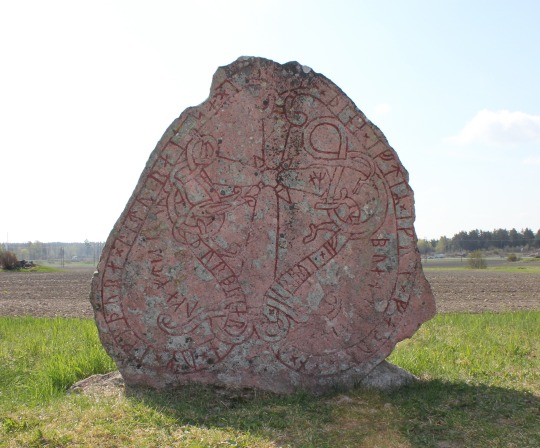
Rune stone # U 151 - Karby, Täby socken
The rune stone, of granite, stands by a road in an agricultural landscape that hasn´t changed much over the past thousand years. The road is lined with rune stones that tell about the people who lived in this area during the 11th century.
*þurbiarn uk ikiþura litu raisa ist(ai)n þina iftiʀ ikul faþur sin uk irinui iftiʀ buanta sin uk aftiR...*
"Torbjörn och Ingetora läto resa denna sten efter Igul, sin fader, och Ärenvi efter sin man och efter... "
Torbjörn and Ingetora had this stone raised in memory of Ígul, their father; and Ärenvi in memory of her husband and in memory of..."
© utrianalax
1 note
·
View note
Photo

Rune stone # Ög 132 - Heda kyrka & socken
The rune stone, which is from the 1000's, was entombed into the wall of the church in the mid-1800s. Jättingstad mentioned on the stone is a small village located approximately 2 km south of Heda church
*hulmstein reisþi stein þena auk bru kiarþi eftiʀ miur faþur sin iʀ buki i iatunstaþum*
Holmsten reste denna sten och gjorde bro efter Myr, sin fader, som bodde i Jättingsstad
"Holmsten raised this stone and made the bridge in memory of Myr, his father, who lived in Jättingstad"
© utrianalax
2 notes
·
View notes
Photo
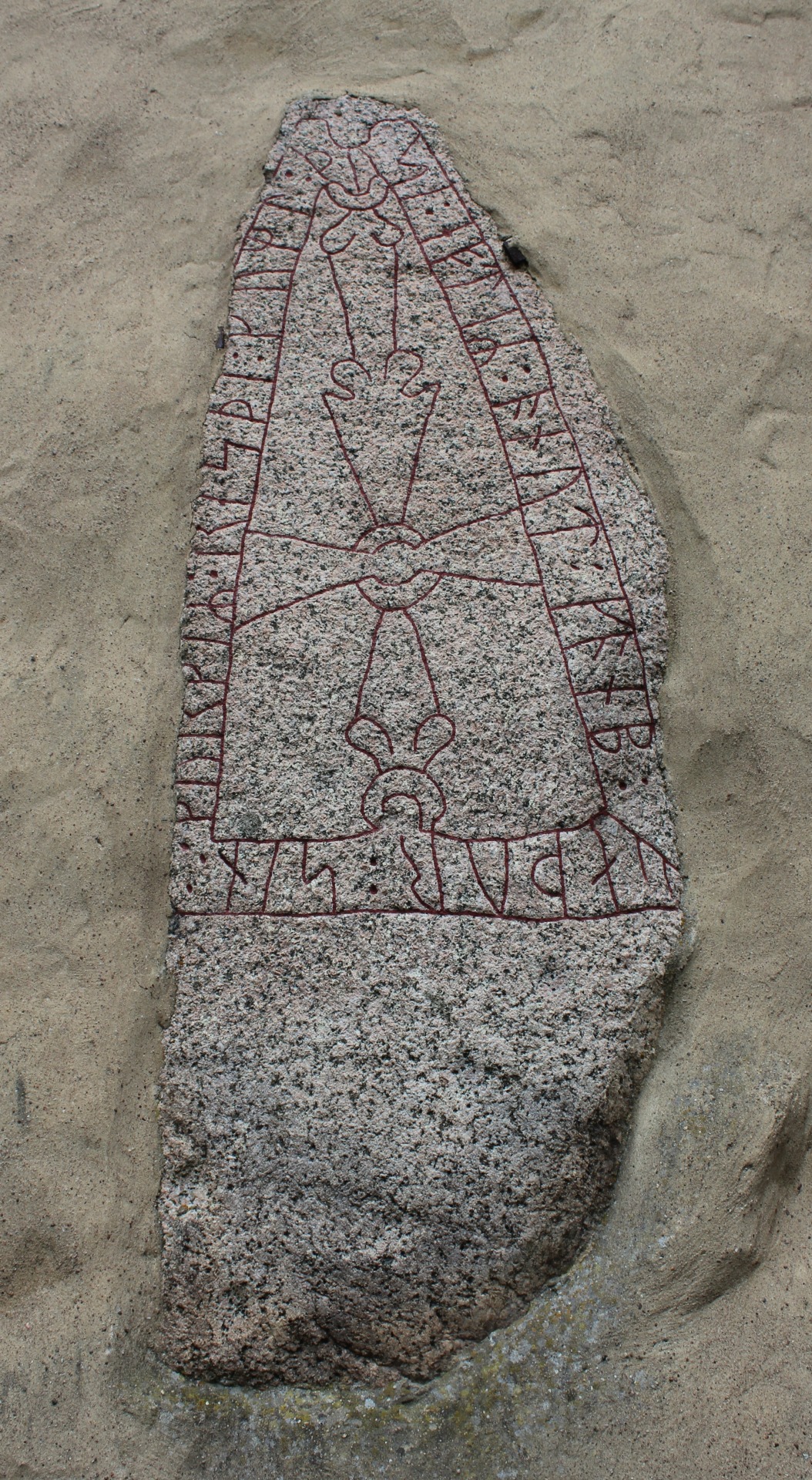
Rune stone # Ög 131 - Heda kyrka & socken
The rune stone was previously in the cemetery but got its present location in the mid-1800s when it was laid into the wall of the church. The stone is 2.10 meters high and made of granite.
To name konb is the same word as the Icelandic kanpr, (kampr) which means 'mustache'. The word has the older writing
*þurkiR resþi kuml þusi eftiR onut konb faþur sin*
"Torger reste detta minnesmärke efter Anund kanp (mustasch), sin fader"
"Torger raised this monument in memory of Anund kanp (Moustache), his father"
© utrianalax
2 notes
·
View notes
Photo
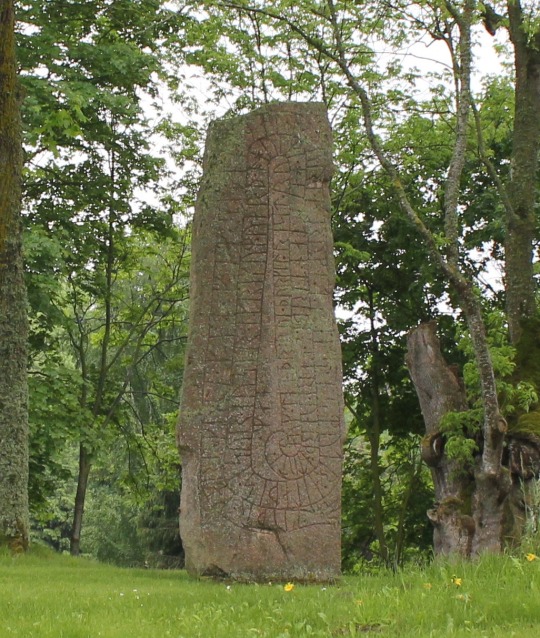

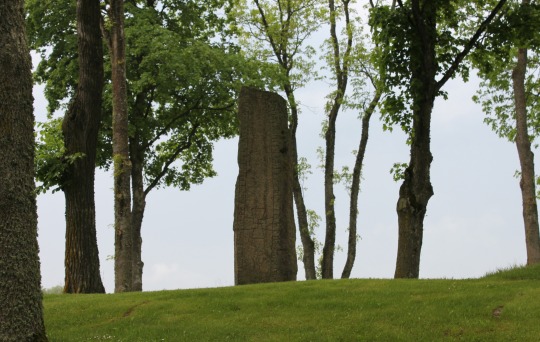
Rune stone # Ög 81 - Högby gamla k:a & socken
The rune stone, found when the church was demolished in 1874, stands on the top of a hill and tells us of the farmer Gulle and his five sons. The runes are carved on both sides of the stone and the sons probably died while on Viking raids, with Assur in particular being named as having died in Greece. Assur was one of the first who is known to have died in the service of the Byzantine Emperor, and he is estimated to have died c. 1010, or in the late 10th century. The son named Åsmund, probably died in the Battle of Fyrisvallen - near Uppsala, in the 980s, and it was probably on the side of king Erik Segersäll (Eric the Victorious).
A nephew, Torgerd, raised the stone.
*þukir resþi stin þansi eftiʀ asur sen muþur bruþur sin iaʀ eataþis austr i krikum kuþr karl kuli kat fim syni feal o furi frukn treks asmutr aitaþis asur austr i krikum uarþ o hulmi halftan tribin kari uarþ at uti auk tauþr bui þurkil rist runaʀ*
"Torgärd reste denna sten efter Assur sin morbroder, som dog österut i Grekland. Söner fick Gulle en god bonde fem. Vid Fyris föll Åsmund orädde kämpen, Assur omkom i öster i Grekland, Halvdan blev på Bornholm dräpt, Kåre vid Dundee, död är ock Boe. Torkel ristade runorna"
"Torgärd raised this stone in memory of Assur, her mother's brother. He met his end in the east in Greece. The good man Gulle got five sons. The brave valiant man Åsmund fell at Fyris, Assur met his end in the east in Greece, Halvdan was killed at Holm (Bornholm); Kåre was (killed) at Dundee, also dead (is) Boe. Torkel carved the runes"
© utrianalax
1 note
·
View note
Photo
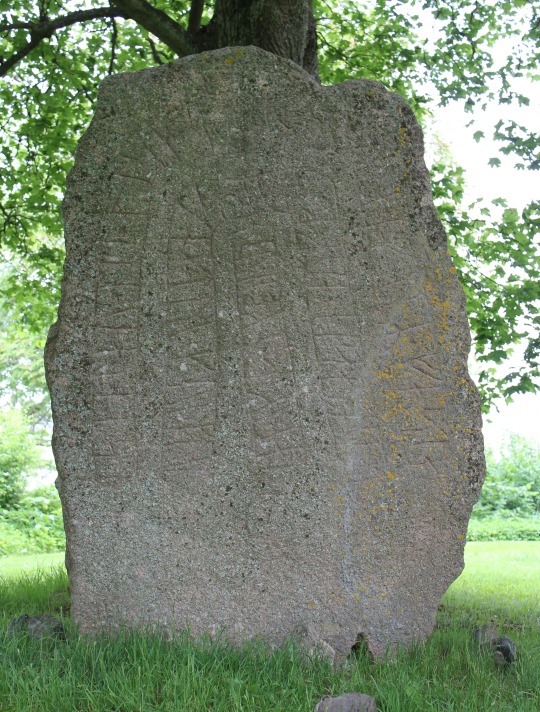
Rune stone # Ög 128 - S:t Lars kyrkohärbärge, Linköping
The rune stone is 2.11 meters tall and stands since 1766 in Valla, near Linköping University. The stone, which dates from the 1000's, was found entombed in a wall in the town during the 1600s. It has been repaired after being split in two pieces.
*santau lit risa stain þinasa iftiR fasta bunta sin auk bruþ sina tua kuþmunt auk sikbiurn*
"Sandö lät resa denna sten efter Faste, sin make, och sina två bröder Gudmund och Sigbjörn"
"Sandö had this stone raised in memory of Faste, her husband, and her two brothers Gudmund and Sigbjörn"
© utrianalax
1 note
·
View note